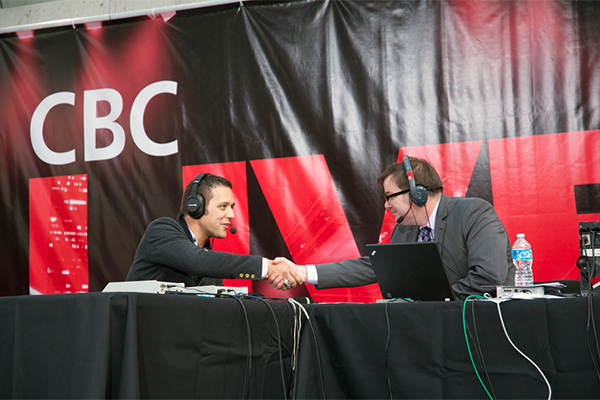 The phenomenon faced by students across the country
The phenomenon faced by students across the country
So you’re in university, working toward a degree… Then what? Do considerations like paying back student loans, settling into a career, or moving in with a partner sometimes feel like too much to handle? You’re not alone. More university students than ever before are struggling with fears about their place in the world. This week, the Fulcrum talks to students and professionals about the phenomenon of the quarterlife crisis.
What’s the deal?
The quarterlife crisis is a term reportedly coined by Abby Wilner in 1997 after she graduated from university and promptly moved back home with her parents. Wilner co-authored the books Quarterlife Crisis: the Unique Challenges of Life in Your Twenties and Quarterlifer’s Companion in an attempt to initiate a conversation about the difficulties faced by students transitioning to adulthood.
Wilner’s website, Quarterlifecrisis.com, reports the average number of times an American switches careers (eight times before the age of 32) and the average debt college graduates acquire (at least $20,000) are major factors contributing to the quarterlife crisis phenomenon.
A May 2011 study led by psychologist Oliver Robinson of the British Psychology Services (BPS) found the people most likely to suffer from quarterlife crises are those who aspire to be successful in conventional terms, yet are unwilling to compromise their idealistic dreams. The study also reported the more
young people tried to pretend all was fine, despite feeling overwhelmed and unhappy, the more they suffered from anxiety and other mental health problems.
Students’ stories
What does a quarterlife crisis look like to today’s students? Brooke Fry, a fourth-year psychology student at Wilfrid Laurier University (WLU), explained her quarterlife crisis was a period characterized by overwhelming worry and uncertainty.
“For me, it’s a baseline of anxiety; you go through it every day and it’s not like you’re ever calm—you just feel anxious all the time,” she said. “School’s very stressful and there’s a lot of pressure, because it’s a very competitive environment.”
While Fry admitted factors like developing new relationships, dealing with financial debts, choosing a religion, and striving to get good grades play into her feelings of confusion, the number one stressor for her is not knowing what lies ahead after school.
“The quarterlife crisis is a feeling of panic toward what you need to do to get somewhere and to do something with your life. You’re thinking of the future,” she said.
Emily Sine, who recently graduated from the U of O with a degree in psychology and linguistics, defines her own personal quarterlife crisis as “a period of confusion and uncertainty” and “betrayal.”
“We’ve been told our entire lives that if we go to university and work really hard, we can get a great paying job in [our] field of choice,” she said. “Those promises come up pretty
short once you’re thrown into the ‘real world’ after 18 years of schooling. The current state of the economy is obviously no help to this situation.”
Nicole Moffett, a third-year U of O student majoring in geography and minoring in applied ethics, has had difficulty settling on a program of study and setting career goals.
“I panic and think that maybe I chose the wrong program and that type of thinking definitely comes from the fact that I have changed my program twice,” she said. “Even now, after finally settling with geography, I am constantly considering different and completely random career paths. These thoughts are definitely the result of a quarterlife crisis and that gut feeling that I have no idea what I am doing and I don’t want to be trapped in a job that I hate.”
Why now?
The process of transitioning from education to the workforce is nothing new, but the issue of quarterlife crises is only now beginning to rear its head.
“I think we probably live in a society that has now been set up for quarterlife crises,” said Marc Molgat, professor of social work at the University of Ottawa.
“There’s a whole bunch of contradictory norms and possibilities of going beyond some of the traditional norms,” he said. “I think that probably poses problems for people.”
Molgat noted young adults are no longer expected to do the same things at the same times as their peers.
“We’re more into a fragmented period where young people follow different pathways or different trajectories,” he said. “Some might find a job and decide to go back to school, because they decide that it’s not exactly what they want to do, so they’ll follow a one-year course then go off to something else. I would say it’s somewhat of a period of exploration and experimentation.”
Julie Gosselin, professor at the U of O’s Department of Psychology, noted the absence of specific guidelines on how to transition into adulthood can be problematic.
“There’s a good reason why we used to have ceremonies to quantify changing from one state of development into another,” she said. “Even if your parents have raised you in a particular faith, for instance, you don’t necessarily have to follow that faith; if your family’s developed a certain career path, you don’t have to follow that.”
Too many choices
One feeling common among students experiencing a quarterlife crisis is that the flexible education system, while liberating, is confusing at the same time.
“People in the past used to go to college to get certain skills to be in certain jobs, so they knew ahead the career path they were going straight into,” said Jessica Maynard, a fourth-year political science major at WLU. “Whereas in university, you go get an arts degree, but then what do you do with an arts degree afterwards? It’s not as defined as other roles that you could be going to do.”
Sine is no stranger to feeling overwhelmed by options, having mulled over multiple career paths and academic endeavours.
“I’ve considered everything from a master’s degree, to applying for jobs out of the country, to taking the [Teachers of English to Speakers of Other Languages] course, to backpacking, and au pairing,” she said. “I even considered living in Mexico for a few months to try and clear my head and figure out what I want. The options are daunting and no one path comes without cons.”
For Sine, having too many choices is debilitating.
“The uncertainty of each option alone just leads to inevitable inaction,” she said. “It’s like a trap—it really just comes down to taking risks.”
The University of Ottawa is a perfect example of a school that offers students an overwhelming number of education options—there are currently 300 programs and 5,000 courses available at the undergraduate level.
“I see more students coming on campus who are more anxious or more stressed out because there are too many choices and they get lost in terms of the numbers,” said Donald Martin, manager of the University of Ottawa’s Counselling and Coaching Services.
“The number of programs or choices that the university has right now—it’s almost exponential. In terms of the minors and majors, students get lost,” he said.
Gosselin noted while students typically regard an abundance of options as a good thing, science tends to disagree.
“There’s been some research that shows the more options you’re being presented with, the less happy you are,” said Gosselin. “This research basically shows as much as you would think it’s nice to have a lot of options, it creates a lot of doubt. As much as you think the options you pick might be good, there are so many others.”
There are also many students who haven’t experienced doubt over career choices and probably never will. Greg Gillette, a recent U of O graduate who is currently pursuing a master’s of science in economic history at the London School of Economics, stated he would not describe his graduation experience as a “crisis.”
“I applied to one [master’s] degree, was accepted, took out the appropriate loans, and booked a plane to London,” he wrote in an email to the Fulcrum. “Had I not been accepted [to the London School of Economics], I would probably be working as a ski bum in New Zealand right now and then applying again to the same degree.”
Gillette admitted there is “certainly a myriad of options” available to him after his finishes his current degree; however, he is “not particularly overwhelmed” by the choices he must make.
“At this point, my only decision is whether or not to continue with a PhD,” he said.
Junaid Ali, a second-year business student from WLU, is another young adult who’s confident with his plan for the future.
“I’ve known what I’ve wanted to get into since I was really young, and over the years it’s become more detailed,” he said. “I started to think I wanted to get into something to do with money, then later business, then later accounting, then later finance.”
So what separates the group of students who are comfortable with their plans from the group questioning their own? While there are several possible answers, Molgat believes it’s not unfair to see an individual’s level of independence as an important factor in their personal confidence through university and beyond.
“People who have been earlier on confronted with becoming independent or having to need to become independent for whatever reason—whether there’s too much family conflict so you have to leave home, or because you just want to be your own person— I would say that those who are able to do that probably have less difficulty making the choices they need to make,” he said.
As the child of separated parents, Ali learned to take care of himself earlier than many of his peers.
“When you become independent at such a young age, you always have to look out for yourself,” he said. “And how do you do that? You think about your future, and you start planning ahead.”
An opportunity for growth
For those experiencing a quarterlife crisis, be reassured the experience need not be a devastating one. The BPS study found 80 per cent of respondents who claimed to have experienced a quarterlife crisis believed the end result was positive.
Gosselin believes, for many students, a period of questioning is quite natural and even beneficial, as it’s important for students to consider their career path before they’ve already committed to it.
“You’re supposed to be lost to some degree,” she said. “A lot of young kids don’t really get the chance to explore opportunities, and they just go with the flow and do what they feel they need to do to get the degree. And then they’re like, ‘Oh, what am I supposed to do with this?’”
When feelings of discomfort begin to set in, Gosselin suggests students take the time to consider the roots of their discomfort rather than dismissing them.
“I think it’s important for everybody to learn when you’re starting to feel negative emotions to tolerate them to some degree,” she said. “We’re happy with good emotions, positive emotions, [and] we don’t really like negative emotions. But emotions in general are information. We’re hard-wired to feel these things, because they’re going to give us information on what’s going on in the world around us and what’s going on in the world inside us. So tuning them out is never really a good option.”
When Gillette needs to make serious decisions, he turns to a pen and piece of paper.
“I list all priorities and options, pros and cons, and establish evaluation criteria and prioritize time for pursuing them,” he said. “That sounds a bit overly systematic, but that’s how I’m dealing with things now. In the past I was a bit more chaotic, usually just biding time until something presented itself and then going that way. The problem is both can end up putting far too much on your plate.”
Martin explained when quarterlife crises are properly managed, they can actually provide an important opportunity for positive personal development.
“I imagine that most of the [students who] have crises, there’s a potential at least that they will learn from it, grow from it, be stronger, and be better,” he said. “This potential is increased if, when they have a crisis, there’s support and they know what to do with it. If there’s proper help, it’s more likely that a crisis can become a teaching moment, or something where you can learn about yourself, and grow, and develop.”
Getting help
If a quarterlife crisis is really an opportunity in disguise, how do students go about capitalizing on the opportunity? For Fry, the first step is talking about the problem.
“I feel like the more I talk about it the better I feel,” she said. “It’s not really that I need to speak to professionals to get advice and help, it’s just that I need to get it off my chest to somebody, it doesn’t really matter who.”
Maynard expressed similar sentiments, saying discussing problems with friends is probably the best way to find solutions.
“It’s easy to talk to someone [who is] experiencing the same thing at the same time as you and the same situation as well—the same generation, the same circumstances,” she said.
Martin notes many students are capable of working through problems on their own, but when a stressful situation persists, it’s important to know that resources are available.
“When students are in trouble, it’s wise to use the support system they have,” he said. “[Students will] do the things that usually work best for them, like have a good night’s sleep, have a good cry, and sometimes the next day they’ll feel better. But if they try the things that usually work and they still feel miserable, then it’s usually an indication that they need to talk to a professional.”
Last thoughts
While the quarterlife crisis seems to be a phenomenon that’s not going anywhere for a while, students need to know that help is available, and when the frustration passes, they’ll probably be better for it.
“I think self-reflection is probably never a very bad thing,” said Gosselin. “To be able to stop for a second and look at where you are and say, ‘Does this feel good?’ I think that’s not a bad thing to do.”
—Written by Keeton Wilcock, with files from Kristyn Filip





